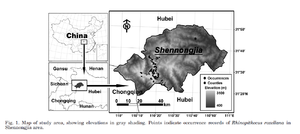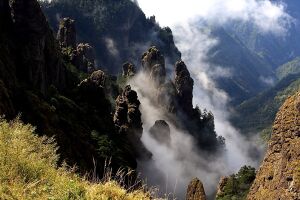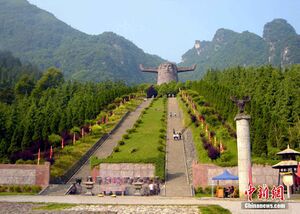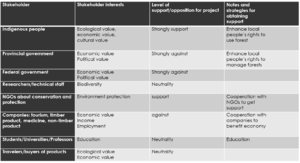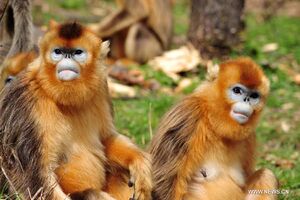Course:FRST370/Protection and management strategies for Shennongjia National Nature Reserve (SNNR), an old growth forest in Hubei Province, China
Case study summary
This study discusses the Shennongjia National Nature Reserve (SNNR), at the eastern end of the Qinba Mountains, located in the northwest of Hubei Province in China. SNNR is a key habitat for the ancient subtropical ruins, rare and endangered species and endemic species, including the Sichuan snub-nosed monkey (Rhinopithecus roxellana) . The ecosystem is complete, and it is the largest area of virgin forest in Central China. The total population of the district is 80,000, and there are 10 ethnic groups. The largest ethnic minority is Tujia. The SNNR is managed by two systems, the Forestry Administration Bureau of Hubei Province (FAB) and the Government of Shennongjia Forest District of Hubei Province (GSF). FAB is in charge of the scientific and protection areas and GSF is responsible for the relationships with local communities . There are many conflicts between biodiversity conservation and community economy development in SNNR, which is managed by top-down approaches These conflicts are mainly about traditional values, cultural values, ecological values and economic values among different stakeholders.
Geographical location
Shennongjia Forest Area was established in 1970 by the State Council with the approval of Guofa [1970] No. 47 document, a county-level administrative district named after the forest area, directly under the jurisdiction of the Hubei Provincial People's Government in China[1]. It is located in the northwestern part of Hubei Province, with Jingxiang in the east, the Three Gorges in the south, Bashu in the west, and Wudang in the north. According to legend, the great ancestor of the Chinese nation, Shennong, used to taste herbs and medicine to save the people. The "jia" in Chinese is a ladder to help climb the mountain. Shennongjia initially refers to the highest peak of the mountain, which is now the Great Shennongjia and Small Shennongjia in the protected area, meaning that Shennong had once reached the highest point of the two mountains. Later it is a mountain range composed of 6 mountain peaks with an altitude of over 3,000 meters as famous as "Huazhong Roof"[2].
Resources description
Shennongjia National Nature Reserve is famous for its biodiversity and nature resources. There are six main types of forests: SNNR contains evergreen broad-leaf forest, evergreen and deciduous broad-leaf mixed forest, deciduous broad-leaf forest, needle-leaf and deciduous broad-leaf mixed forest, dark needle-leaf forest and meadow. Besides, SNNR contains five first-class protected plants species (51 total in China) and 16 second-class protected plants species (67 species total in China). Besides, 254 species of animals (altogether 1951 species in China) belong to ‘the list of protected animals with high economic, scientific value'. [3]
SNNR was established early and has the only well-preserved subtropical forest ecosystem in the mid-latitude inland region of the northern hemisphere. It is famous for its abundant animal and plant resources. SNNR has a vertical height difference of 2,700 m. From the bottom to the top, there are evergreen broad-leaved forests, evergreen deciduous broad-leaved mixed forests, deciduous leaves, broad-leaved forests, coniferous and broad-leaved mixed forests, coniferous forests, subalpine shrubs, and meadows. It is neither fully covered by the Quaternary glaciers nor severely affected by the anticyclone and cold currents of the Mongolian-Siberian continent[4]. Therefore, it is regarded as a well-preserved evergreen deciduous broad-leaved mixed forest and a complete vertical band spectrum. And it is also a concentrated source of temperate flora in the world and the most concentrated area of global temperate distribution, and the most abundant area of deciduous woody plants in the world. SNNR has 874 species of 245 genera and 77 families of deciduous woody plants, accounting for 44.5% of the total number of wild seed plants in the area, 24.8% of the total genera and 24.7% of the total species . In addition, a key habitat for the ancient subtropical, rare, endangered and endemic species. For example, the flora of the Shennongjia National Nature Reserve was basically formed before the Paleogene and Neogene. There are 139 families and 597 genera of vascular plants originating before the Neogene, accounting for 65.9% and 55.7% of the families and genus of vascular plants, respectively. 95% of the Chinese endemic genus is monotypic or oligogenic[5].
History and population
1986, SNNR set up by China central authority. 1990, SNNR become a member of the International Network of Biosphere Reserves by United Nations Educational, Scientific and Cultural Organization (UNESCO). 1995, SNNR became one project of the China Nature Reserve Management Program, with support of Global Environment Facility (GEF). [3]
There are residents of various ethnic groups such as Tujia, Miao, Yi, Hui and Han. Among the total population, ethnic minorities account for 78%, of which 96% are Tujia. Except for the Han nationality, Tujia is the most populous nation which occupies 4.7% of the total population of the region, accounting for 70% of the minority population[2].
Existing managements
For more than a decade, Shennongjia has accumulated a total of 68,318 mu of forests. Closing hills for afforestation and returning farmland to forests has resulted in 420,000 mu of new and old deforested forests. The forest coverage rate has risen to 70.1%, the protected areas have reached more than 85%, and the standing stocks have recovered to 150 million cubic meters. However, new problems in the construction of ecological environment occurs--animals compete with people. After the implementation of the three major projects of natural forest protection, returning farmland to forests and grassland and wildlife protection, the natural environment is continuously optimized, wild animals and plants are rehabilitated, and wild species populations grow rapidly. Golden monkeys, Sumen antelopes, leopards, and other endangered animals began to appear. The most worried thing is that macaques, wild boars, and black bears often appear, causing extreme losses to the production and life of local residents. Due to the laws and regulations of nature reserves, local Tujia people cannot cause any form of harm to them, otherwise, they will be sanctioned by law. According to the statistics of Xiaguping Township, in 2009, a total of 1,631 households in 6 villages in the township were invaded by wild animals, and the area of grain damage was 3,998 mu. It can be said that at the government level, this issue has not been effectively resolved[1].
At present, there are five protection-focused management strategies. The first one is to establish in situ conservation areas for rare and endangered plants in areas where the endangered plants are concentrated in the heritage sites, and adopt appropriate human intervention measures to increase the rate of rare and endangered plants. The second strategy is to establish long-term fixed monitoring plots, regularly monitor and strictly protect the vertical distribution of mountain vegetation vertical spectrum, and prohibit logging. And the third one is between the two areas separated from each other, a mosaic pattern of “corridors – stepping stones – passages” is constructed to allow the communication of wild animals and plants and the connection of ecosystem functions. In addition, the management of the heritage sites in accordance with the restricted areas and display areas. Among them, the original natural state must be maintained in the restricted area. Moreover, establish the World Natural Heritage Integrated Management Committee to establish a long-term mechanism for the joint work of the SNNR[5].
Tenure arrangements
1986, SNNR set up by China central authority;
1990, SNNR become a member of the International Network of Biosphere Reserves by United Nations Educational, Scientific and Cultural Organization (UNESCO);
1995, SNNR became one project of the China Nature Reserve Management Program, with support of Global Environment Facility (GEF). [3]
As an administrative unit named after a nature reserve, the work of nature reserves must of course rank first. At this point, they are consistent with the Shennongjia Nature Reserve Administration. However, as a local government, the development of the local economy and the living conditions of the residents should also be the top priority of the work. How to balance ecological protection with economic development in terms of policies can be said to be a problem faced by the local government. [1]
All of the property is owned by the state and has national or provincial protection status. Hubei Shennongjia is subject to a range of national, provincial and local laws and regulations which ensure long term strict protection. A multi-level management system has been established to manage the property. The property is subject to a number of plans and has a specific Hubei Shennongjia Management Plan tailored to World Heritage requirements and aimed at safeguarding the site’s Outstanding Universal Value. [6]
Administrative arrangements
The Administration Bureau of Shennongjia National Nature Reserve (ABS) is managed by two systems: the Forestry Administration Bureau of Hubei Province (FAB) and the Government of Shennongjia Forest District of Hubei Province (GSF). FAB is in charge of the scientific and protection areas and GSF is responsible for dealing with the relationships between ABS and the local communities in the Forest District. however, local farmers in SNNR have very little participation in the management issues. Firstly, local people lack access to the tradition of democracy and secondly the government ignored the rights and interests of local people. In a paper by Chen et al., the authors introduced the concept of Community Co-management to help local communities participate into nature reserve management activities. [3]
In 1970, the State Council approved the establishment of the reserve, and the original forest areas of Xingshan, Badong and Fangxian formed the “Shen Nongjia Forest Area”, which is directly under the jurisdiction of Hubei Province. It is the only administrative area named after the “Forest Area” in China. The land area of the whole district is 3,253 square kilometers, and there are 6 towns and 2 townships (Songbai Town, Muyu Town, Yangri Town, Hongping Town, Xinhua Town, Jiuhu Town, Songluo Township, Xiagu Township) and three county-level units. (Forestry Administration, National Nature Reserve Administration, National Wetland Park Administration) and 2 deputy county-level units (Muyu Provincial Tourism Resort, Panshui Ecological Industrial Park). It has a national forest and wildlife nature reserve, a national forest park, a national geological park, a national wetland park, a provincial tourist resort, and a 5A scenic spot. [2]
Biodiversity hot spot
Shennongjia National Nature Reserve is a significant example of the proceeding ecological procedure which happens in the development of entire subtropical mixed broad-leaved evergreen and deciduous forests in the Northern Hemisphere. This reserve is also a distinctive example of mountain altitudinal biological zones in the Oriental Deciduous Forest Biogeographical Province. Shennongjia is also a major origin location for global temperate flora, and holds the highest number of global temperate genera of trees. In addition, the heritage of Shennongjia displays unusual biodiversity and is a major habitat for numerous relic, rare, endangered and endemic species. Shennongjia National Nature Reserve has the highest richness of deciduous woody species in the world. It is important to deep understand of protecting, monitoring and managing the remarkable world heritage in the Northern Hemisphere. [5]
It is the concentrated source of temperate flora in the world and the most concentrated area of global temperate distribution.
· According to statistics, China's temperate distribution belongs to about 931 genera, which is the most concentrated region in the world.
· Western Hubei is the most abundant temperate flora, the birthplace of the temperate flora in the world, and the distribution center for the differentiation and development of temperate flora.
· The Shennongjia World Natural Heritage Site has a temperate distribution of 590 genera, covering 63.3% of the temperate distribution of China.
It is the most abundant area of deciduous woody plants in the world.
· Shennongjia World Natural Heritage Site has 874 species of 245 genera and 77 families of deciduous woody plants, accounting for 44.5% of the total number of wild seed plants in the area, 24.8% of the total genera and 24.7% of the total species.
· The Great Smoky Mountains National Park is considered to be the region with the largest number of deciduous woody plants in North America. According to the IUCN World Heritage Center assessment report, Great Smoky Mountains has the richest deciduous tree species in the world's temperate forests, with about 200 deciduous shrubs, but far less than the 874 species of Shennongjia World Natural Heritage. [5]
A key habitat for the ancient subtropical, rare, endangered and endemic species.
· The flora of the Shennongjia National Nature Reserve was basically formed before the Paleogene and Neogene. There are 139 families and 597 genera of vascular plants originating before the Neogene, accounting for 65.9% and 55.7% of the families and genus of vascular plants, respectively. 95% of the Chinese endemic genus is monotypic or oligogenic.
· The SNNR is an important habitat for species such as Ranodon shihi, Hynobius chinensis, and Andrias davidianus. This fully illustrates the ancient nature of flora and fauna of the Shennongjia National Nature Reserve.
· 110 species and 48 species were listed as endangered by the IUCN Red List, and 94 species and 74 species were included in the Convention on International Trade in Endangered Species of Wild Fauna and Flora (CITES). And the heritage site is also the only habitat of Rhinopithecus roxellana hubeiensis. [5]
Affected Stakeholders-local farmers
There are residents of various ethnic groups such as Tujia, Miao, Yi, Hui and Han. Among the total population, ethnic minorities account for 78%, of which 96% are Tujia. [1]
Local farmers are the main affected stakeholders in SNNR, who have very little participation in the management issues. Local people's lives are highly dependent on the forests. 81% of them believe the conservation policy reduces their incomes due to termination of their traditional livelihood mode, such as hunting, medicinal materials collecting, log cutting. Approximately 20% of the respondents think that the establishment of SNNR will help to reduce natural disaster and improve their living environment. Local people lack access to the tradition of democracy and secondly the government ignored the rights and interests of local people. [3] Due to the laws and regulations of nature reserves, local Tujia people cannot cause any form of harm to them, otherwise they will be sanctioned by law. [1]
There are lot of resources in SNNR for tourism development, such as beautiful scenery, plenty of rare, endangered, endemic plants and animals, mysterious stories, interesting custom, etc. In recent years, income from the travel industry has been increasing. The total income of sightseeing from the ticket office had reached about two million RMB in the year of 2000. [3]
Interested stakeholders-inside and outside
Shennongjia National Nature Reserve is important in the development of entire subtropical mixed broad-leaved evergreen and deciduous forests in the Northern Hemisphere. Shennongjia is also a major origin location for global temperate flora, and holds the highest number of global temperate genera of trees. In addition, the heritage of Shennongjia displays unusual biodiversity and is a major habitat for numerous relic, rare, endangered and endemic species. [5] Under this situation, there are many interested stakeholders involved in both inside and outside.
For local people who live locally but not completely rely on the forest and forest resources, they are highly interested in management. Besides, they also focus on protecting biodiversity, reduce overlogging, and maintain sustainability in local forest. For provincial government who have highest authority of SNNR, they have legal authority rights to most forests. Governments consider about environmental issues as well. But they also consider about economic growth and ecotourism income as revenue.
For some NGOs focusing on conservation protection, they are highly interested but less influential. For researchers who are interested economically, politically and environmentally, they are highly interested. For companies who rely on forests to make profits, they are highly interested and moderately influential. For example, tourism companies, furniture companies and timber factories by using timber products, food companies collecting non-timber products and even medicine companies. Besides, there are many visitors every year since SNNR is a famous national park in China. Visitors are also in the highly interested category as well.
Sichuan snub‐nosed monkeys (Rhinopithecus roxellana)-endangered species in SNNR
There are five kinds of golden monkeys in the world namely the Chuan golden snub-nosed monkey, the Black snub-nosed monkey, the Gray snub-nosed monkey, the Vietnam golden snub-nosed monkey, and the Burmese golden snub-nosed monkey (called the Nujiang golden monkey), which was discovered in 2011. It is classified into the Primates, Cercopithecidae, Rhinopithecus, in the taxonomy. [2]
The Sichuan snub-nosed monkey is endangered and it is one of four species in the genus Rhinopithecus. The ecosystems of Sichuan snub-nosed monkey are Pleistocene refugia for many endemic and rare species. And protect primates is to protect ecosystems in Pleistocene refugia. The distribution of the primate is in mountain areas which are 1,500 m to 3,300 m above sea level in broadleaf and coniferous forest in Sichuan, Gansu, Shanxi and Hubei provinces of China. And those habitats are threatened with habitat destruction and illegal hunting. SNNR is one of the main habitat of snub-monkeys. [7]
Main factors which affect habitat preference:
· Habitat preference may be affected by food supply and predation risk.
· Monkeys eat lichen nearly in all year, especially in the winter when lacking of food. And lichen is especially important for the monkeys.
· Compared to other habitats, monkeys in the primary forest has lower predation risk. Because trees in primary forest have more complicate structure and monkeys could have better protection to get rid of other predators.
Conservation implications
· It is important to establish a habitat conservation priority for the primate.
· Result shows that deforestation has decreased the quality of primary forest as well as monkey’s habitats.
· Deforestation caused forest fragmentation.
In order to protect the habitat of monkeys, primary forest should be conserved as a top priority and the clear-cutting of forest should be prohibited.
Climate change influenced R. roxellana in SNNR
The distributional range of R. roxellana will be significantly reduced in the Shennongjia area in response to climate change and human impact, especially by the years 2050 and 2080, compared to the current situation. There are two spatial responses for wild animals affected by global warming and habitat destruction and fragmentation: upward migration that shif their distributions to higher elevations and polar ward migration that shift their distributions northward in the North Hemisphere. Range reductions in response to elevational, latitudinal, and longitudinal gradients, with the monkeys forced to migrate to higher elevations over time. Bioclimatic factors, such as temperature, precipitation, evapotranspiration, and aridity condition, were dominant contributors to range shifting. [4]
Discussion
Limitation of development locally
The development in SNNR was limited by many different issues. The population in Shenongjia will increase in the future, which may cause problems for environment, resources competition. The educational level of farmers in Shenongjia is relatively low at present: only 30% people above seven (school entrance age) could have access to high school education and only 1% people received college education. For the attitude to development from local residents, 87% of them think that development confines their living area. 81% of them think that conservation policy reduces their incomes by terminating their traditional living mode, such as hunting, medicinal materials collecting, log cutting. 20% of them believe that establishment will help to reduce natural disaster and improve their living.The average income locally was 1044.4 RMB per capita in 2001, which is below the national average number. (RMB: Chinese Currency, 8.3 RMB=1 US$). Income of local people mainly come from the traditional crops and stockbreeding (44.9%). Besides, there is also income from ecotourism and acorn selling as well. [3]
Human-animal conflict
After the implementation of the three major projects of natural forest protection, returning farmland to forests and grassland and wildlife protection, the natural environment is continuously optimized, wild animals and plants are rehabilitated, and wild species' populations grow rapidly. Golden monkeys, Sumen antelopes, leopards, and other endangered animals began to appear. The most worrying thing is that macaques, wild boars, and black bears often appear, causing extreme losses to the production and life of local residents. [1]
According to the statistics of Xiaguping Township, in 2009, a total of 1,631 households in 6 villages in the township were invaded by wild animals, and the area of grain damage was 3,998 mu. [1]
In fact, the phenomenon of animals and people competing for food is not a unique phenomenon in the Shennongjia Nature Reserve, nor is it a problem that has arisen now.
It is one of the most effective means for the Tujia people to solve the problem of animals and people competing for a long time in a planned and reasonable way to hunt wild animals such as wild boars. The government’s practice of not allowing a certain number of wild boars to be hunted is essentially paralyzed by “extreme biocentrism”[1]
Biodiversity protection and land transformation in SNNR
Importance of biodiversity
· Biodiversity from the genetic level to the landscape level is valuable and important to humans, which provides essential goods, services, information and aesthetic value.
· Transformation from natural vegetation to crop cultivation and urban development is common all over the world and which is also main threat to global biodiversity due to habitat degradation, human activities.
· Areas with a high biodiversity value are important to the conservation of biodiversity. [8]
C0-management
There are some conflicts between sustainable development of community economy development and biodiversity conservation in SNNR. Community Co-management is suggested to mediate conflict here. [3]
Co-management is a situation in which two or more social actors negotiate, define, and guarantee amongst themselves an equitable sharing of the management functions, entitlements, and responsibilities for a given territory or set of natural resources. Co-management agreements are commonly used to deal with natural resource conflicts among indigenous people, state agencies, and other stakeholders for equal participation. Although these stakeholders may hold different interests, sharing authority and decision making will promote resource management, making it more responsive. Co-management could increase stakeholder participation and enhance efficiency and equity. Co-management is used to resolve conflicts such as the struggle of indigenous people to resist state and private resource appropriation. Conflict is a major factor for different stakeholders to negotiate co-management arrangements. Some rural groups have difficulty in participating in negotiation, including indigenous people, due to costs, distance, state's power and lack of expertise on issues related to community-based property rights. However, co-management could bring new conflicts and cause old ones to escalate. It is the case that states often have high-level control over resource policy, management, and allocation and ignore and marginalize indigenous communities. Resource conflicts can become severe and the potential results could be violence, resource degradation, the undermining of livelihoods, and the uprooting of communities. [9]
Recommendations-suggestions
Conservation hot‐spots/suggestions in the Shennongjia area
· Comprehensive conservation strategies should be carried out immediately for this primate species, [insert name of species] in Shennongjia area.
· Identification of representative areas suitable for population sustainability.
· Securing existing reserves and establishing new reserves;
· Re‐designing management systems to include the Shenongjia reserve and the surrounding reserves and highlighting ecosystem protection at higher elevations;
· Using finer‐scale research to guide the conservation planning and education in order to enhance protection and awareness in the local community.
· Comprehensive conservation strategies should be carried out immediately for this primate species in Shennongjia area.
· Additional efforts in population monitoring, habitat restoration, local community education, and management and restriction of human activities (deforestation, agriculture) or illegal hunting are required, to counteract the trends of population decrease and habitat loss for the golden snub‐nosed monkey.[4]
Formulation of policies
· the development of policies and action plans to protect habitats and species on privately owned land,
· the careful investigation of future transformation within priority conservation areas,
· the promotion of sustainable agriculture rather than extensive agriculture on marginal lands,
· the investigation of species and habitats in identified conflict areas at a local scale,
· the promotion of buffers of natural habitat,
· the prevention of degradation of rangelands,
· the rehabilitation of abandoned fields,
· a decrease in the use of agricultural pesticides, herbicides and fertilizers,
· a decrease in the poisoning of wild life, such as birds of prey,
· the promotion of biodiversity within agricultural landscapes as an indicator of ecosystem “health”. [8]
Protected management strategies that are in place:
· Establish in situ conservation areas for rare and endangered plants in areas where the endangered plants are concentrated in the heritage sites, and adopt appropriate human intervention measures to increase the rate of rare and endangered plants.
· Establish long-term fixed monitoring plots, regularly monitor and strictly protect the vertical distribution of mountain vegetation vertical spectrum, and prohibit logging.
· Between the two areas separated from each other, a mosaic pattern of “corridors – stepping stones – passages” is constructed to realize the communication of wild animals and plants and the connection of ecosystem functions.
· The management of the heritage sites in accordance with the restricted areas and display areas. Among them, the original natural state must be maintained in the restricted area.
· Establish the World Natural Heritage Integrated Management Committee to establish a long-term mechanism for the joint work of the SNNR. [5]
References
- ↑ 1.0 1.1 1.2 1.3 1.4 1.5 1.6 1.7 Ren, Guoying (2011). "Ecology and Livelihood:A Study on Food Fight between the Animal and the Human at the Tujia Ethnic Township of Xiaguping, Shennongjia National Nature Reserve". Ethno-National Studies. 5.
- ↑ 2.0 2.1 2.2 2.3 "神农概况 (Shennong Overview)". Shennongjia Government Official website. Retrieved November 26, 2019.
- ↑ 3.0 3.1 3.2 3.3 3.4 3.5 3.6 3.7 Chen; et al. (2005). "Economic development of local communities and biodiversity conservation: a case study from Shennongjia National Nature Reserve, China". doi:10.1007/s10531-004-4360-2: 2095–2108. Explicit use of et al. in:
|last=(help) - ↑ 4.0 4.1 4.2 Luo, Zhenhua; Zhou, Surong; Yu, Wendi; Yu, Huiliang; Yang, Jingyuan; Tian, Yanhong (2015). "Impacts of climate change on the distribution of Sichuan snub‐nosed monkeys (Rhinopithecus roxellana) in Shennongjia area, China". American Journal of Primatology: 135–151.CS1 maint: multiple names: authors list (link)
- ↑ 5.0 5.1 5.2 5.3 5.4 5.5 5.6 Xie, Zongqiang; Shen, Guozhen; Zhou, Youbing; Fan, Dayong; Xu, Wenting; Gao, Xianming; Du, Yanjun; Xiong, Gaoming; Zhao, Changming; Zhu, Yan (2017). "The outstanding universal value and conservation of the Shennongjia". Biodiversity Science. 25: 490–497.CS1 maint: multiple names: authors list (link)
- ↑ "Hubei Shennongjia". United Nations Education, Scientific and Cultural Organization.
- ↑ Li, Y (2014). "The effect of forest clear-cutting on habitat use in Sichuan snub-nosed monkey (Rhinopithecus roxellana) in Shennongjia Nature Reserve, China". Primates. 1: 69–72.
- ↑ 8.0 8.1 Wessels, Reyers, Jaarsveld, & Rutherford, (2003). "Identification of potential conflict areas between land transformation and biodiversity conservation in north-eastern South Africa". Agriculture, Ecosystems and Environment: 157–178.CS1 maint: extra punctuation (link) CS1 maint: multiple names: authors list (link)
- ↑ Castro, A. P., & Nielsen, E. (2001). "Indigenous people and co-management: implications for conflict management": 229–239. Cite journal requires
|journal=(help)CS1 maint: multiple names: authors list (link)
| This conservation resource was created by Feng,Yutong; Qu,Xianya;. |
